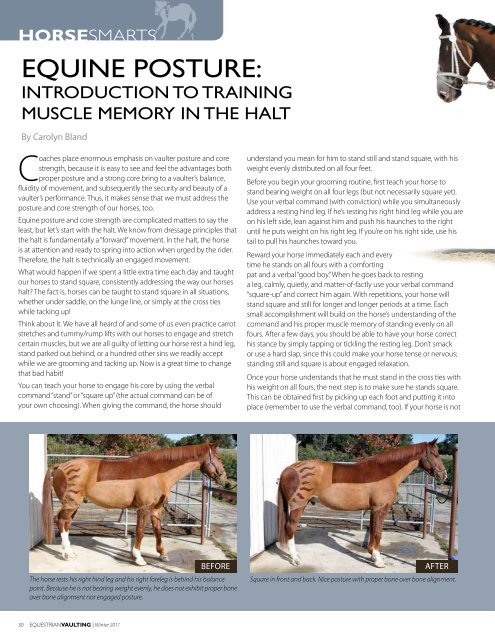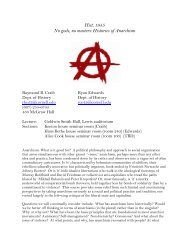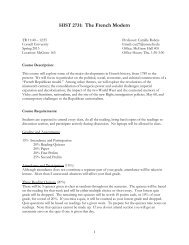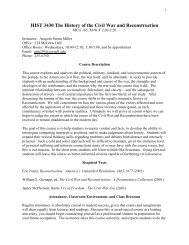VaultinG - Cornell University Department of History
VaultinG - Cornell University Department of History
VaultinG - Cornell University Department of History
Create successful ePaper yourself
Turn your PDF publications into a flip-book with our unique Google optimized e-Paper software.
hOrsesMarts<br />
eQuine Posture:<br />
introduction to trAining<br />
muscle memorY in the hAlt<br />
By Carolyn Bland<br />
Coaches place enormous emphasis on vaulter posture and core<br />
strength, because it is easy to see and feel the advantages both<br />
proper posture and a strong core bring to a vaulter’s balance,<br />
fluidity <strong>of</strong> movement, and subsequently the security and beauty <strong>of</strong> a<br />
vaulter’s performance. Thus, it makes sense that we must address the<br />
posture and core strength <strong>of</strong> our horses, too.<br />
Equine posture and core strength are complicated matters to say the<br />
least, but let’s start with the halt. We know from dressage principles that<br />
the halt is fundamentally a “forward” movement. In the halt, the horse<br />
is at attention and ready to spring into action when urged by the rider.<br />
Therefore, the halt is technically an engaged movement.<br />
What would happen if we spent a little extra time each day and taught<br />
our horses to stand square, consistently addressing the way our horses<br />
halt? The fact is, horses can be taught to stand square in all situations,<br />
whether under saddle, on the lunge line, or simply at the cross ties<br />
while tacking up!<br />
Think about it. We have all heard <strong>of</strong> and some <strong>of</strong> us even practice carrot<br />
stretches and tummy/rump lifts with our horses to engage and stretch<br />
certain muscles, but we are all guilty <strong>of</strong> letting our horse rest a hind leg,<br />
stand parked out behind, or a hundred other sins we readily accept<br />
while we are grooming and tacking up. Now is a great time to change<br />
that bad habit!<br />
You can teach your horse to engage his core by using the verbal<br />
command “stand” or “square up” (the actual command can be <strong>of</strong><br />
your own choosing). When giving the command, the horse should<br />
30 EquEstrian<strong>VaultinG</strong> | Winter 2011<br />
understand you mean for him to stand still and stand square, with his<br />
weight evenly distributed on all four feet.<br />
Before you begin your grooming routine, first teach your horse to<br />
stand bearing weight on all four legs (but not necessarily square yet).<br />
Use your verbal command (with conviction) while you simultaneously<br />
address a resting hind leg. If he’s resting his right hind leg while you are<br />
on his left side, lean against him and push his haunches to the right<br />
until he puts weight on his right leg. If you’re on his right side, use his<br />
tail to pull his haunches toward you.<br />
Reward your horse immediately each and every<br />
time he stands on all fours with a comforting<br />
pat and a verbal “good boy.” When he goes back to resting<br />
a leg, calmly, quietly, and matter-<strong>of</strong>-factly use your verbal command<br />
“square-up” and correct him again. With repetitions, your horse will<br />
stand square and still for longer and longer periods at a time. Each<br />
small accomplishment will build on the horse’s understanding <strong>of</strong> the<br />
command and his proper muscle memory <strong>of</strong> standing evenly on all<br />
fours. After a few days, you should be able to have your horse correct<br />
his stance by simply tapping or tickling the resting leg. Don’t smack<br />
or use a hard slap, since this could make your horse tense or nervous;<br />
standing still and square is about engaged relaxation.<br />
Once your horse understands that he must stand in the cross ties with<br />
his weight on all fours, the next step is to make sure he stands square.<br />
This can be obtained first by picking up each foot and putting it into<br />
place (remember to use the verbal command, too). If your horse is not<br />
BEFOrE AFTEr<br />
The horse rests his right hind leg and his right foreleg is behind his balance Square in front and back. Nice posture with proper bone over bone alignment.<br />
point. Because he is not bearing weight evenly, he does not exhibit proper bone<br />
over bone alignment nor engaged posture.





